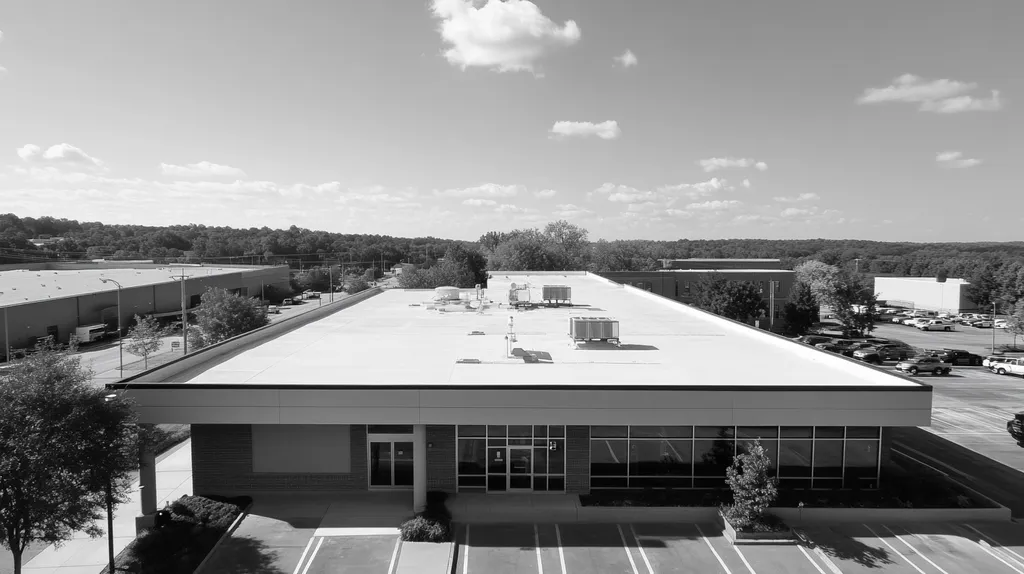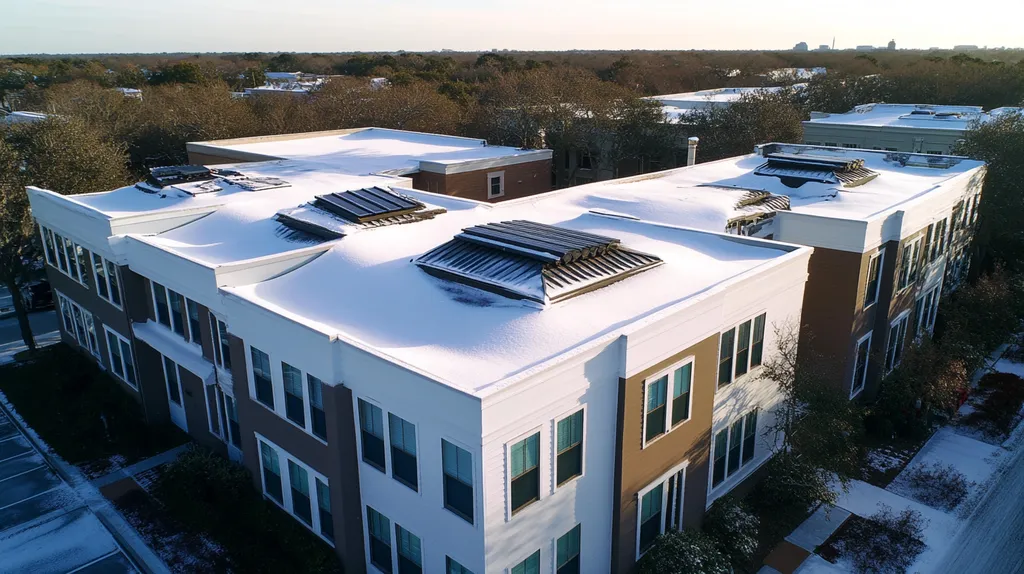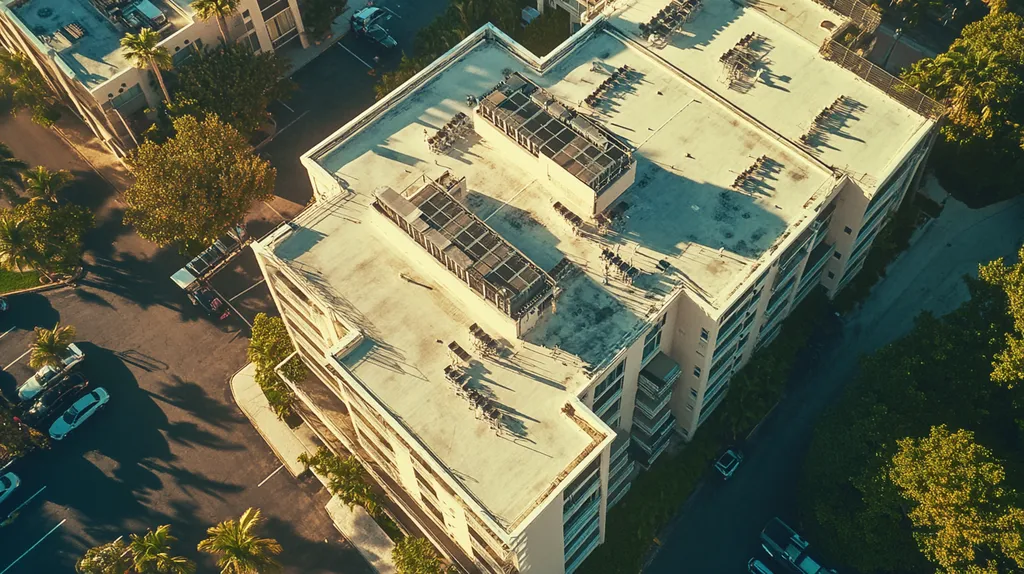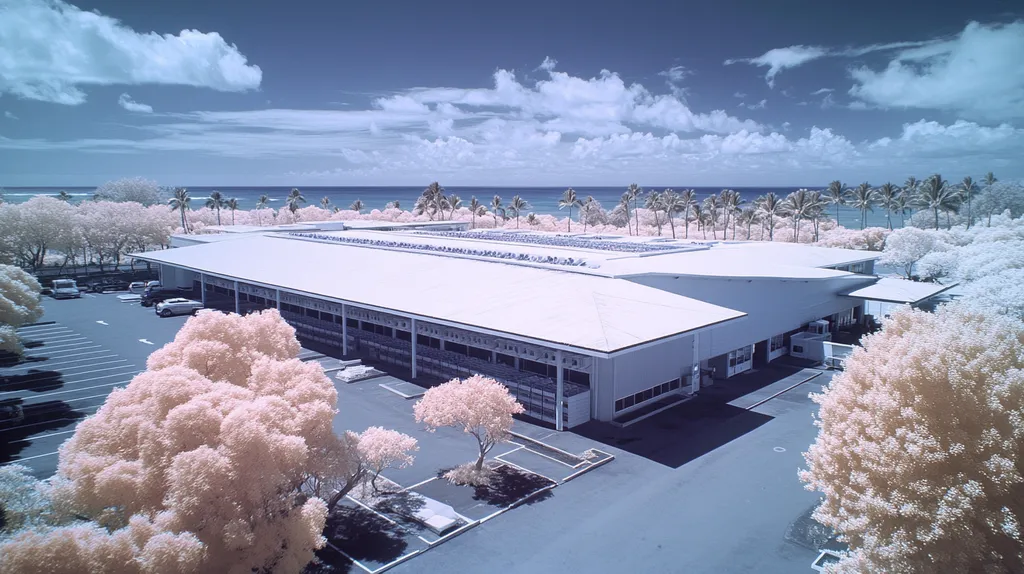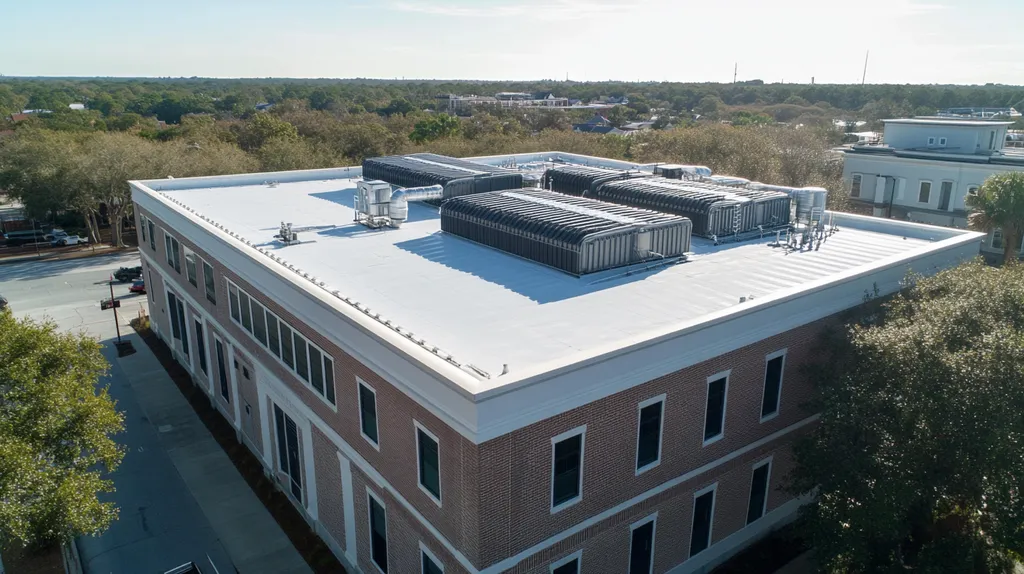Commercial property owners face mounting pressure as neighboring developments reshape urban landscapes, with studies showing up to 40% higher maintenance costs for roofs impacted by adjacent construction and changes in local environments.
From altered wind patterns to increased debris exposure, neighboring properties can significantly influence a roof’s performance, durability, and longevity.
This comprehensive guide equips property professionals with actionable strategies to evaluate and address these impacts across six critical areas: performance, finances, compliance, risk management, operations, and long-term planning.
SECTION 1: PERFORMANCE FACTORS
The design of a commercial roof extends far beyond mere appearance or budget. It critically affects energy efficiency, climate resilience, and structural soundness. As energy prices rise and weather events grow more extreme, property owners and facility managers must recognize how neighboring developments can influence roof performance. Failing to adapt to local impacts can lead to unnecessary energy waste and inflated maintenance costs, highlighting the need for informed roofing practices for long-term success.
Energy Efficiency and Sustainability
Energy efficiency in commercial roofing is vital for keeping operational costs low and promoting sustainability. Roofs often contribute significantly to a building’s total energy use. Incorporating energy-efficient materials, such as reflective coatings or living roofs, can yield impressive savings over time.
Consider how neighboring structures like towering buildings or expansive trees may create shifting shading effects that directly influence solar gain. In warmer climates, heat-absorbing surfaces can significantly increase energy demands. By understanding local surroundings, property professionals can pick the most suitable materials and designs for enhanced energy performance.
Additionally, sustainable roofing methods have gained importance in the current market. Vegetative roofs not only improve insulation but also minimize stormwater runoff, offering dual benefits. It’s crucial to assess these eco-friendly options while considering neighboring structures.
Lastly, being aware of local zoning codes is critical, as they may enforce specific energy efficiency standards. Being proactive in adapting to these parameters can greatly boost a building’s value and overall investment potential.
Key Action Items
Weather Resistance and Climate Adaptability
Weather resistance is essential for ensuring a commercial roof’s longevity. With more frequent extreme weather events, selecting roofing materials that can endure regional climate challenges has never been more critical. For instance, roofs in hurricane-prone regions must be designed for superior wind resistance, while properties in snowy areas need to manage the weight and drainage from melting snow.
Neighboring developments can greatly influence these requirements. Nearby buildings may alter wind patterns, increasing stress on roofs. Property owners must take these geographical factors into account when planning new roofing systems or retrofitting existing ones.
Moreover, local climate data should dictate the choice of roofing materials. Some options may not perform well in humid environments, leading to potential mold issues. By examining local weather trends, property managers can make informed decisions that enhance their roof’s durability.
Monitoring forecast changes is also essential; temperature variations can cause thermal expansion and contraction in roofing materials, leading to premature wear. Regularly assessing weather-related impacts can help identify vulnerabilities early on, preventing costly repairs down the road.
Key Action Items
Structural Integrity and Durability
Structural integrity is critical when evaluating the suitability of a commercial roof. A poorly designed or neglected roof can create serious safety hazards and financial strains. Neighboring developments can impose extra loads or stressors, such as shifting soil or increased debris, requiring careful design considerations.
The choice of high-quality materials is fundamental for long-lasting durability. For example, specific membranes provide better resistance against punctures and tears, especially in environments affected by construction debris. Property managers should select materials that fortify structural elements, especially in densely populated settings.
It’s also important to consider the aging process of roofing materials. Exposure to the sun, moisture, and activities in the surroundings can accelerate deterioration. Regular maintenance and inspections can catch early signs of wear, allowing for timely interventions that preserve the roof’s structural integrity.
Understanding the broader environment—both physically and regarding regulations—equips property professionals with the knowledge needed to ensure their roofs are built to endure, protecting investments for the long haul.
Key Action Items
SECTION 2: FINANCIAL CONSIDERATIONS
Understanding the financial implications of roofing decisions is vital for commercial property owners. A roof that is poorly designed can lead to excessive maintenance costs, decreased property value, and reduced market appeal. In fact, studies indicate that improper roofing design can inflate operational costs by over 20% annually. By addressing financial considerations related to neighboring developments, property professionals can safeguard against unexpected expenses and enhance profitability.
Initial Investment and ROI Analysis
The initial investment in a commercial roof is substantial, but evaluating the return on investment (ROI) is essential. A well-designed roof, taking neighboring developments into account, can yield significant benefits in energy efficiency and longevity.
For instance, properties adjacent to new developments may need roofs that accommodate changes in drainage or withstand increased wind loads. Investing in these essential features upfront can prevent costly modifications in the future.
Furthermore, incorporating energy-efficient materials often leads to reduced utility bills, positively impacting overall ROI. Property owners can typically expect approximately a 30% decrease in energy costs with the right roofing design.
Key Action Items
Maintenance and Repair Costs
Routine maintenance and repair costs significantly impact a roof’s overall life cycle. Properties located near construction zones often face increased debris and potential damage from ongoing activities.
Failing to account for these external factors can lead to inflated repair budgets. Anticipating more frequent maintenance due to neighboring developments can help avoid unnecessary expenses associated with debris-related wear or changes in environmental conditions.
Regular inspections are key, especially in rapidly developing areas where minor issues can escalate quickly. A proactive maintenance strategy can reduce long-term costs significantly, with some property owners saving up to 50% on unexpected repairs.
Key Action Items
Impact on Property Value and Market Appeal
The design of a commercial roof significantly influences property value and marketability. Prospective tenants or buyers frequently prioritize roof condition during their evaluation process.
In areas experiencing growth from neighboring developments, properties featuring well-implemented roofs that consider local environmental factors become more attractive. For example, roof systems that effectively manage stormwater can enhance property value by tens of thousands of dollars.
Additionally, properties with low-maintenance requirements or strong sustainability credentials attract higher-quality tenants willing to pay premium rates. A well-designed roof can increase leasing rates by up to 15%, underscoring its critical role in market appeal.
Key Action Items
SECTION 3: COMPLIANCE REQUIREMENTS
Compliance requirements are crucial for the success of any commercial roofing project. Local building codes and regulations can significantly influence your design choices and installation methods. In an ever-evolving urban environment, overlooking these codes can lead to hefty fines and project delays. Property professionals must stay informed about energy efficiency standards and zoning regulations to ensure smooth roofing installation.
Local Building Codes and Regulations
Local building codes create the essential legal framework for roofing installations. These codes govern structural integrity, material selection, and required safety measures. For example, in areas that experience heavy snowfall, roofs must be designed to support the extra weight.
Non-compliance can incur penalties and necessitate expensive rework. To prevent this, property professionals should thoroughly review local codes prior to finalizing roof designs, ensuring that safety and durability are prioritized.
Moreover, staying updated on local code revisions is essential as municipalities often adjust these requirements to address emerging safety and environmental issues. Engaging with local building authorities early in the planning process can help streamline approvals and minimize potential setbacks.
Key Action Items
Energy Efficiency Standards and Certifications
Energy efficiency standards, such as those from the U.S. Green Building Council, play a pivotal role in roofing decisions. These guidelines promote the use of materials and designs that reduce energy consumption and environmental impact. For instance, reflective roofing can significantly cut cooling costs in warmer areas.
Familiarity with certifications like LEED (Leadership in Energy and Environmental Design) can provide competitive advantages. Properties that achieve such certifications often reap lower operating costs and boosted market value, particularly in competitive real estate markets.
Investing in energy-efficient roofing solutions can also bring government incentives or rebates. By prioritizing certified products, property owners can enhance both sustainability and financial returns, making long-term strategies more appealing.
Key Action Items
Zoning and Land Use Compliance
Zoning regulations are crucial in shaping the design and implementation of commercial roofs, especially in densely populated areas. These rules dictate how properties can be utilized and significantly impact roof design choices, like height restrictions and material types.
For instance, a commercial building located near residential zones may face stricter guidelines regarding noise and aesthetics. Understanding these nuances enables property managers to avoid disputes and fines, making early engagement with local planning departments essential.
Zoning considerations may also influence drainage systems and rooftop greenery. Properties might be required to use green roofs or manage stormwater effectively to align with local expectations. Addressing these requirements can enhance both the ecological profile and usability of the property.
Key Action Items
SECTION 4: RISK MANAGEMENT
Proactive risk management is crucial for commercial and industrial roofing. Property owners must be vigilant in shielding their assets from potential hazards linked to neighboring developments. Research shows that unaddressed risks can inflate repair costs by as much as 45%. This section will explore possible hazards and vulnerabilities, provide strategies for mitigating weather-related risks, and underscore the significance of fire and impact resistance in roofing design.
Identifying Potential Hazards and Vulnerabilities
Evaluating nearby developments is essential for recognizing risks that could jeopardize a roof’s stability. Proximity to taller buildings or busy streets can result in increased debris, altered water runoff, or even shading, which may disrupt drainage and ventilation systems.
For instance, roofs situated near construction zones are at risk of vibrations or falling materials. Conducting a comprehensive risk assessment during the design phase enables property owners to identify and address external threats proactively. Ignoring these issues can lead to extensive damage over time.
Additionally, properties close to industrial areas might face greater air pollution, potentially corroding roofing materials more quickly. Regular inspections and preventive maintenance serve as effective strategies to mitigate these environmental dangers.
Key Action Items
Mitigating Weather-Related Risks
Weather-related risks can pose serious threats to commercial roofs. Nearby developments may unintentionally worsen these conditions, such as creating wind channels or increasing runoff during rainfall. Understanding local weather patterns and how new buildings or landscapes interact with them is crucial for effective risk management.
For example, roofs that must bear heavy snowfall should feature adequate slope and structural support. Likewise, buildings near bodies of water should incorporate advanced drainage systems to avert ponding issues.
Employing durable roofing materials like thermoplastic or modified bitumen can substantially boost resilience against severe weather. Property managers should aim to comply with or exceed local weather codes to enhance roof longevity and functionality.
Key Action Items
Ensuring Fire and Impact Resistance
Fire and impact resistance are vital considerations in roofing design, particularly in densely populated urban areas. Roofs must be engineered to withstand fire hazards from nearby structures and flying debris due to storms. Non-combustible materials should be prioritized for roofs situated near industrial zones or areas prone to wildfires.
For example, opting for steel or concrete roofing provides significant advantages against fire risks. Specialized coatings can offer additional fire protection while enhancing the roof’s lifespan. Proper insulation is also critical to prevent overheating, which can heighten fire risks.
Additionally, neighboring developments might add threats like debris from construction or nearby vegetation. Thus, roofs must be designed to resist physical impacts and comply with local safety regulations. Regular inspections are essential for maintaining these safety features, protecting both the building and the surrounding community.
Key Action Items
SECTION 5: OPERATIONAL PROCEDURES
In the world of commercial roofing, neglecting operational procedures can lead to serious drawbacks, including expensive repairs and safety risks. Research shows that a well-maintained roof can last up to 20% longer than one that is poorly managed. This section underscores the importance of implementing robust operational protocols with regular inspections, timely issue resolution, and comprehensive training for facility staff. These proactive measures can prevent small problems from escalating into costly setbacks, thereby protecting property investments.
Regular Inspection and Maintenance Checklists
A systematic approach to regular inspections is crucial for maintaining a roof’s integrity. Comprehensive checklists should cover visual inspections, moisture assessments, and debris removal. For instance, a quarterly checklist might include checking for ponding water, inspecting flashing and seams, and clearing drainage systems. Each inspection should conclude with documented findings to monitor the roof’s condition over time.
Facility managers must align inspections with environmental changes and nearby developments. For example, if a new building increases debris risk, inspection frequency should be adjusted. This proactive strategy effectively addresses potential issues before they escalate, safeguarding not just the roof but the entire infrastructure.
Seasonal maintenance tasks should also be included in these checklists. For winter, preparations may involve checking insulation and sealing gaps to prevent heat loss. Tailoring the checklist to seasonal and site-specific factors enhances the roof’s performance throughout its lifespan.
Key Action Items
Addressing Roofing Issues and Repairs
Quickly addressing roofing issues is vital for prolonging a roof’s lifespan. Minor problems, like small leaks or surface damage, can rapidly escalate if not promptly handled. For example, a leak around an HVAC unit can result in significant roof deterioration and indoor moisture issues if ignored. Scheduling immediate repairs helps minimize secondary damage and protects the entire facility.
A centralized reporting system for observed issues allows facility staff to communicate effectively regarding potential roofing concerns. This system helps prioritize urgent repairs and track resolutions, promoting accountability. Such an organized approach streamlines the repair process and reduces disruption to facility operations.
For major repairs or replacements, obtaining multiple bids from qualified contractors is advisable. This not only ensures competitive pricing but allows for a comprehensive evaluation of solutions tailored to specific needs. Ultimately, the aim is to establish a responsive repair strategy that mitigates impacts from neighboring developments.
Key Action Items
Training and Documentation for Facility Staff
Providing training for facility staff on roofing maintenance and documentation is critical to empower them in managing roof conditions effectively. Regular training sessions can highlight best practices, potential warning signs, and the significance of timely reporting. Staff should be well-equipped to identify issues like membrane cracks or distortion, indicating underlying concerns.
Maintaining an organized documentation system is also essential. Records of inspections, repairs, and communications with contractors should be easily accessible. Proper documentation ensures historical data informs future maintenance strategies and repair schedules, facilitating compliance with safety regulations and warranties.
Fostering open communication about roof-related issues cultivates a proactive culture within the team. Implementing straightforward reporting tools can help capture data on roof conditions, encouraging urgent attention to emerging problems. Combining thorough training with meticulous documentation prepares facility staff to safeguard the integrity of the commercial roof.
Key Action Items
SECTION 5: OPERATIONAL PROCEDURES
In the realm of commercial roofing, overlooked operational procedures can lead to significant consequences, including costly repairs and safety risks. Research shows that an effectively maintained roof can last up to 20% longer than one that is neglected. This section highlights the necessity of implementing robust operational protocols that encompass regular inspections, swift issue resolution, and thorough training for facility staff. Together, these measures can prevent minor setbacks from evolving into major problems, thereby protecting property investments.
Regular Inspection and Maintenance Checklists
A systematic approach to regular inspections is crucial for maintaining the roof’s integrity. A comprehensive checklist should include visual inspections, moisture assessments, and debris removal. For example, a quarterly checklist might feature tasks such as checking for ponding water, inspecting flashing and seams, and ensuring drainage systems are clear. Each inspection should conclude with documented findings to monitor the roof’s condition over time.
Facility managers should align inspections with environmental changes and nearby developments. For instance, if a new structure increases the risk of debris accumulation, the inspection frequency should be adjusted accordingly. This proactive strategy helps address potential issues early, safeguarding not just the roof but the entire facility.
Additionally, these checklists should incorporate seasonal maintenance tasks. Winter preparations may involve checking insulation and sealing gaps to prevent heat loss. By modifying checklists to reflect seasonal conditions and site-specific factors, property managers can enhance the roof’s performance and longevity.
Key Action Items
Addressing Roofing Issues and Repairs
Swiftly addressing roofing issues is essential for prolonging the roof’s lifespan. Minor concerns, such as small leaks or surface damage, can escalate dramatically if not promptly remedied. For instance, a leak around an HVAC unit can trigger extensive roof deterioration and moisture problems indoors. Scheduling immediate repairs minimizes secondary damage and protects the integrity of the entire facility.
A centralized reporting system for any observed issues empowers facility staff to communicate effectively about potential roofing concerns. This system helps prioritize urgent repairs and tracks resolutions, fostering accountability. Such a structured approach streamlines the repair process and reduces disruption to facility operations.
When facing significant repairs or full replacements, obtaining multiple bids from qualified contractors is prudent. This ensures competitive pricing and allows for a thorough assessment of solutions tailored to specific needs. Ultimately, the objective is to establish a responsive repair strategy that mitigates negative impacts from neighboring developments.
Key Action Items
Training and Documentation for Facility Staff
Training facility staff on roofing maintenance and documentation is vital to empower them to effectively manage roof conditions. Regular training sessions can highlight best practices, potential warning signs, and the importance of timely reporting. Staff should be trained to recognize issues such as membrane cracks or distortion, which could suggest underlying concerns.
Moreover, a well-organized documentation system is crucial. This includes records of inspections, repairs, and communications with contractors. Accessible documentation ensures that historical data informs future maintenance strategies and repair schedules, facilitating compliance with safety regulations and warranty requirements.
Encouraging open communication among staff about roofing-related issues fosters a proactive culture. Implementing simple reporting tools can help capture data on roof conditions and promote timely attention to emerging problems. A combination of thorough training and meticulous documentation equips facility staff to preserve the integrity of the commercial roof.
Key Action Items
Looking Ahead
With neighboring developments directly impacting up to 40% of commercial roof performance and maintenance costs, property professionals cannot afford to ignore their surroundings when designing roofing solutions.
The increasing density of urban environments means that adjacent structures, from towering buildings to industrial facilities, create unique challenges for every commercial roof.
Success requires a comprehensive approach spanning performance optimization, financial planning, regulatory compliance, risk management, and operational excellence.
By implementing the strategies and checklists outlined in this guide, property owners and facility managers can transform potential challenges into opportunities, ensuring their roofs remain resilient, efficient, and valuable assets for decades to come.
The time to act is now, as urban development continues to accelerate and environmental pressures intensify.
FREQUENTLY ASKED QUESTIONS
Q. How does a commercial roof’s design impact energy efficiency?
A. The design plays a crucial role in energy efficiency by influencing solar gain and insulation. Neighbors’ tall buildings or trees can create shade, affecting a roof’s temperature. Using energy-efficient materials can significantly reduce costs over time, benefiting long-term sustainability.
Q. What financial factors should I consider for my industrial roof?
A. Consider initial costs, potential returns on investment, and maintenance expenses. A well-designed roof can lower operational costs, making it essential to evaluate long-term financial benefits against upfront investment. Additional costs may arise from poor design, so thorough planning is vital.
Q. How important are compliance requirements for a commercial roof?
A. Compliance with local building codes is essential to avoid fines and ensure safety. These regulations dictate material selection and structural integrity. Engaging with local authorities during planning can smooth the approval process and prevent costly adjustments later.
Q. What risk management strategies should I implement for my commercial roof?
A. Conducting risk assessments helps identify potential hazards like debris and environmental factors. Implementing durable materials and proper drainage will mitigate weather-related issues. Regular inspections can proactively address problems, preventing unexpected repair costs and extending the roof’s lifespan.
Q. How can operational procedures enhance my commercial roof’s integrity?
A. Regular inspections, timely repairs, and staff training are key to maintaining roof integrity. A systematic approach to monitoring conditions enables early detection of issues. Documenting all maintenance helps in strategizing future tasks, contributing to longer roof life and reducing costs.
Q. What should I include in a roofing maintenance training for facility staff?
A. Training should cover best practices for regular inspections, recognizing warning signs, and timely reporting. Include information on common roofing issues and their implications. Providing staff with access to historical data can enhance their ability to manage the roof effectively.
Q. How do neighboring developments affect commercial roof design?
A. Nearby buildings can alter wind patterns, shading, and drainage needs, all impacting roof design. Assessing these factors helps ensure effective solutions and longevity. Being proactive in design considerations allows for tailored roofs that withstand environmental challenges posed by adjacent structures.

